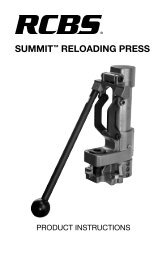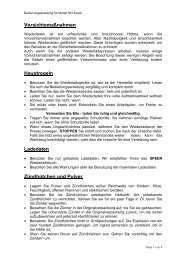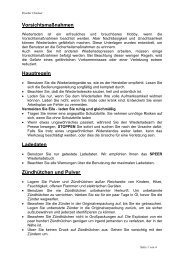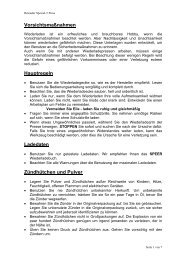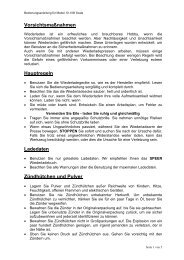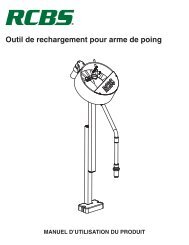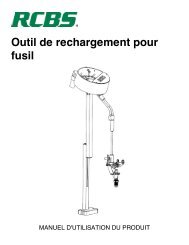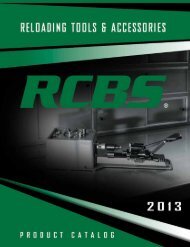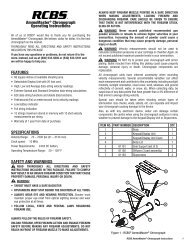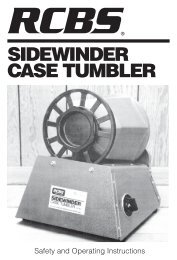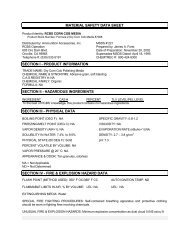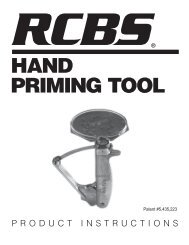Lube Die Instructions - RCBS
Lube Die Instructions - RCBS
Lube Die Instructions - RCBS
Create successful ePaper yourself
Turn your PDF publications into a flip-book with our unique Google optimized e-Paper software.
LUBE DIE<br />
PRODUCT INSTRUCTIONS
SAFETY<br />
Reloading is an enjoyable and rewarding hobby that is easily conducted<br />
with safety. But carelessness or negligence can make reloading<br />
hazardous. This product has been designed from the beginning with<br />
the user’s safety in mind.<br />
As with any reloading operation, some safety rules must be followed.<br />
By observing these few rules, the chance of hazardous occurrence<br />
causing damage or injury becomes extremely remote.<br />
GENERAL<br />
• Use the reloading equipment as the manufacturer recommends.<br />
Study the instructions carefully and become thoroughly familiar<br />
with the operation of the product. Don’t take short cuts.<br />
• Observe “good housekeeping” in the reloading area. Keep tools<br />
and components neat, clean and orderly. Promptly and<br />
completely clean up primer and powder spills.<br />
• Reload only when you can give your undivided attention. Do not<br />
reload when fatigued or ill. Develop a reloading routine to avoid<br />
mistakes. Avoid haste—load at a leisurely pace.<br />
• Always wear adequate eye protection. You assume unnecessary<br />
risk when reloading without wearing safety glasses.<br />
LOADING DATA<br />
• Use only laboratory tested reloading data. We highly recommend<br />
the use of the SPEER Reloading Manual.<br />
• OBSERVE ALL WARNINGS ABOUT THE USE OF MAXIMUM<br />
LISTED LOADS.<br />
PRIMERS AND POWDER<br />
• WARNING: Primers are designed to explode and will do so when<br />
subjected to heat or percussion.<br />
• DO NOT decap live primers.
• Never attempt to seat or reseat a primer in a loaded round.<br />
• Store primers and powder beyond the reach of children and away<br />
from heat, dampness, open flames and electrical equipment.<br />
• DO NOT use primers of unknown identity. Dispose of unknown<br />
primers in accordance with applicable regulations.<br />
• Keep primers in original factory container until ready to use.<br />
Return unused primers to the same factory packaging for safety<br />
and to preserve their identity.<br />
• DO NOT store primers in bulk. The blast of just a few hundred<br />
primers is sufficient to cause serious injury to anyone nearby.<br />
• DO NOT force primers. Use care in handling primers.<br />
• DO NOT use any powder unless its identity is positively known.<br />
Discard all mixed powders and those of uncertain or unknown<br />
identity.<br />
• If you use a powder measure, replace the lids on both the powder<br />
hopper and powder can after the powder hopper has been filled.<br />
• Before charging cases, settle the powder in the powder hopper.<br />
Throw and check the weight of at least ten charges. This will<br />
assure you that the correct powder charge is being thrown.<br />
• After a reloading session ends, pour the remaining powder back<br />
in its original factory container. This will preserve the identity and<br />
shelf life of the powder.<br />
• DO NOT smoke while handling powder or primers.<br />
RECORD KEEPING<br />
• Keep complete records of reloads. Apply a descriptive label to each<br />
box showing the date produced, and the primer, powder and bullet<br />
used. Labels for this purpose are packed with SPEER bullets.<br />
Since <strong>RCBS</strong> has no control over the choice of components, the<br />
manner in which they are assembled, the use of this product, or the<br />
guns in which the resulting ammunition may be used, no responsibility,<br />
either expressed or implied, is assumed for the use of ammunition<br />
reloaded with this product.
LUBE DIE COMPATIBILITY CHART<br />
Use the chart below to determine which <strong>Lube</strong> <strong>Die</strong> to use for a<br />
specified caliber. If a number is not indicated, then a <strong>Lube</strong> <strong>Die</strong> is not<br />
available for that caliber.<br />
<strong>Lube</strong><br />
Caliber <strong>Die</strong><br />
17 Remington 1<br />
218 Bee —<br />
22 Hornet —<br />
22K-Hornet —<br />
22 Remington Jet —<br />
22 Savage High-Power 3<br />
22-250 Remington (22 Varminter) 2<br />
220 Swift 3<br />
221 Remington Fire Ball 1<br />
222 Remington 1<br />
222 Remington Magnum 1<br />
223 Remington (5.56mm) 1<br />
5.6 x 50mm Rimmed —<br />
240 Weatherby Magnum 2<br />
243 Winchester 2<br />
6mm PPC 1<br />
6mm Remington (244 Remington) 2<br />
25 Auto (25 ACP) —<br />
25-06 2<br />
25-20 Winchester —<br />
25-35 Winchester 3<br />
250 Savage (250-3000 Savage) 2<br />
257 Roberts 2<br />
257 Roberts Improved 40° 2<br />
257 Weatherby Magnum 4<br />
260 Remington 2<br />
264 Winchester Magnum 4<br />
6.5mm-06 2<br />
6.5 x 52mm Carcano 3<br />
6.5 x 54mm Mannlicher-<br />
Schoenmauer —<br />
6.5 x 55mm Swedish Mauser 2<br />
6.5 x 57mm Mauser 2<br />
<strong>Lube</strong><br />
Caliber <strong>Die</strong><br />
6.5 x 68Smm 4<br />
270 Weatherby Magnum 4<br />
270 Winchester 2<br />
280 Remington (7mm Exp. Rem.) 2<br />
284 Winchester 4<br />
7mm Bench Rest Remington 2<br />
7mm Remington Magnum 4<br />
7mm Remington Ultra Magnum –<br />
7mm Shooting Times Westerner 4<br />
7mm Thompson/Center Ugalde 1<br />
7mm Weatherby Magnum 4<br />
7mm-08 Remington 2<br />
7 x 57mm Mauser (7mm Mauser) 2<br />
7 x 64mm Brenneke 2<br />
7 x 65mm Rimmed 2<br />
7-30 Waters 3<br />
30 M-1 Cabine —<br />
30 Luger (7.65mm Luger) —<br />
30 Mauser (7.63mm Mauser) —<br />
30 Remington 3<br />
30-06 Springfield 2<br />
30-30 Winchester 3<br />
30-338 Winchester Magnum 4<br />
30-378 Weatherby Magnum —<br />
30-40 Krag —<br />
300 H&H Magnum 4<br />
300 Remington Ultra Magnum —<br />
300 Savage 2<br />
300 Weatherby Magnum 4<br />
300 Winchester Magnum 4<br />
303 British —<br />
307 Winchester 2<br />
308 Norma Magnum 4
<strong>Lube</strong><br />
Caliber <strong>Die</strong><br />
308 Winchester 2<br />
7.5mm x 54 French MAS 2<br />
7.5mm x 55 Schmidt-Rubin —<br />
7.62 x 39mm .308/.311 3<br />
7.62 x 54Rmm Russian .308/.311 —<br />
7.65 x 53mm Belgian Mauser 2<br />
7.7 x 58mm Japanese Arisaka 2<br />
32 Automatic (7.65mm Auto) —<br />
32 H&R Magnum —<br />
32 Smith & Wesson Long —<br />
32 Winchester Special 3<br />
32-20 Winchester —<br />
32-40 Winchester 3<br />
8mm Lebel French Revolver —<br />
8mm Remington Magnum 4<br />
8mm-06 2<br />
8 x 57mm Mauser (8mm Mauser) 2<br />
8 x 68Smm Magnum —<br />
338 Lapua —<br />
338 Remington Ultra Magnum —<br />
338 Winchester Magnum 4<br />
338-06 2<br />
338-378 Weatherby Magnum —<br />
340 Weatherby Magnum 4<br />
348 Winchester —<br />
35 Remington 3<br />
35 Whelen 2<br />
350 Remington Magnum 4<br />
356 TSW —<br />
356 Winchester 2<br />
357 Magnum —<br />
357 Remington Maximum —<br />
357 SIG 3<br />
358 Winchester 2<br />
9mm Luger —<br />
9mm Makarov —<br />
9 x 21 —<br />
<strong>Lube</strong><br />
Caliber <strong>Die</strong><br />
9 x 23mm Winchester —<br />
9.3 x 62mm Mauser 2<br />
9.3 x 74Rmm —<br />
375 H&H Magnum 4<br />
375 Winchester 3<br />
376 Steyr 4<br />
378 Weatherby Magnum —<br />
38 Casull 2<br />
38 Colt Super Auto —<br />
38 Smith & Wesson —<br />
38 Special —<br />
380 Automatic (ACP) —<br />
38-40 Winchester —<br />
38-55 Winchester & Ballard 3<br />
40 S&W —<br />
40-65 Shiloh Sharps-408" 4<br />
400 CorBon 2<br />
405 Winchester 3<br />
10mm Auto —<br />
41 Magnum 4<br />
416 Remington Magnum —<br />
416 Rigby —<br />
44 Magnum —<br />
44 Special —<br />
444 Marlin —<br />
44-40 Winchester —<br />
45 Automatic (45 ACP) 2<br />
45 Colt —<br />
45-70 U.S. Government 4<br />
450 Marlin 4<br />
454 Casull —<br />
458 Winchester Magnum 4<br />
460 Weatherby Magnum —<br />
475 Linebaugh 1.400" —<br />
50 Action Express —<br />
50-70 U.S. Government —
GENERAL INFORMATION<br />
Lubricating cases prior to resizing is an important and necessary step in the<br />
reloading process. The use of the <strong>RCBS</strong> <strong>Lube</strong> <strong>Die</strong> eliminates the sometimes<br />
unpleasant method of lubricating cases by hand. With the <strong>Lube</strong> <strong>Die</strong> a cartridge<br />
is lubricated and decapped in a single motion.<br />
• Faster and easier than hand lubricating<br />
• Keeps hands clean when reloading<br />
• Less handling of cases prior to reloading<br />
• Standard 7 /8-14 thread fits most presses<br />
• Easy to refill with <strong>RCBS</strong> Case <strong>Lube</strong>-2<br />
The <strong>RCBS</strong> <strong>Lube</strong> <strong>Die</strong> can be use in single-stage presses or progres<br />
sive reloading tools with a minimum of four stations.<br />
There are four <strong>Lube</strong> <strong>Die</strong>s available. Each <strong>Lube</strong> <strong>Die</strong> lubes and decaps the<br />
case in one operation. See the <strong>Lube</strong> <strong>Die</strong> Compatibility Chart for the correct<br />
<strong>Lube</strong> <strong>Die</strong> to use.<br />
The following instructions are for using the <strong>Lube</strong> <strong>Die</strong> in a progressive<br />
reloading tool with a minimum of four stations.<br />
PREPARING THE LUBE DIE<br />
Lay the <strong>Lube</strong> <strong>Die</strong> on its side. Push the rubber seal ring toward the top of the<br />
Push the rubber seal ring up to<br />
expose the fill hole.<br />
Fill the <strong>Lube</strong> <strong>Die</strong> with <strong>RCBS</strong> Case<br />
<strong>Lube</strong>-2.
die until the fill hole in the die is exposed. Insert the top of the Case <strong>Lube</strong>-2 bottle<br />
in the fill hole and give the bottle one good squeeze to force the Case <strong>Lube</strong>-<br />
2 into the <strong>Die</strong>.<br />
INSTALLING THE LUBE DIE<br />
The <strong>Lube</strong> <strong>Die</strong> is installed in the first station of the progressive reloading<br />
press. Allow about 1 /32" (approximately 1 /2 turn) between the bottom of the <strong>Lube</strong><br />
<strong>Die</strong> and the shell plate when the ram is at the top of the stroke. Position the<br />
lube fill hole toward the front of the press so that it is easily accessible when<br />
it's time to refill. The decapping pin should extend about 3 /16" below the bottom<br />
of the die. The <strong>Lube</strong> <strong>Die</strong> must sit in the press about 30 minutes to allow the<br />
Case <strong>Lube</strong>-2 to saturate the felt lubricating bushing. Leave the fill hole uncovered<br />
until the felt bushing is saturated with lubricant. Failure to allow time for<br />
the lubricant to saturate the felt bushing can result in a case being stuck in the<br />
sizer die.<br />
The decapping pin should extend 3 /16" below the bottom of the <strong>Lube</strong> <strong>Die</strong>.
INSTALLING THE RELOADING DIE SET<br />
The sizer die should be installed at station 2. The expander-decapping unit<br />
in the sizer die must be backed up so that it will not decap the newly seated<br />
primer. Or, you can remove the decapping pin entirely. Powder charging should<br />
take place at station 3. The seater die should be installed in station 4.<br />
Adjust the decapping pin in the sizer die to avoid decapping the newly<br />
seated primer.<br />
USING THE LUBE DIE<br />
Cases must be properly lubricated prior to resizing or they will stick in the<br />
sizer die. Excessive lubricant will cause dented or collapsed shoulders on bottle<br />
neck cases. Before reloading, check the felt lubricating bushing for lubricant.<br />
This is easily done by running an unlubricated case into the <strong>Lube</strong> <strong>Die</strong>.<br />
Remove the case from the die and inspect it carefully. There should be a light<br />
film of lubricant all around the case with none on the case shoulder. If there<br />
appears to be an excessive amount of lubricant on the case, run several cases<br />
through the die to soak up the excessive lubricant. Wipe the cases clean with<br />
a damp cloth and repeat if necessary. When you are satisfied the proper level<br />
of lubrication has been obtained, you are ready to proceed with reloading.<br />
One filling of the <strong>Lube</strong> <strong>Die</strong> with lubricant will last for 100 to 250 cases,<br />
depending on the case size. Add lubricant as soon as you detect increased sizing<br />
pressure and a noticeable absence of lubricant on the case.
LUBE DIE STORAGE<br />
The die may be left in the reloading press or stored in its plastic storage<br />
box. The die should be stored in the vertical position when full of lubricant. A<br />
case must be left in the die to prevent lubricant leakage. Prior to using the die<br />
again, remove the case and follow the procedures outlined in “USING THE<br />
LUBE DIE.” If excessive lubricant collects on the decapping unit, remove it<br />
from the die and wipe with a damp cloth.<br />
HELPFUL HINTS<br />
• Do not over-fill the lube retainer with case resizing lubricant. As a<br />
general guide, squeeze (with light pressure) the Case <strong>Lube</strong>-2<br />
bottle for 8 to 10 seconds when filling the lube retainer.<br />
• Slide the rubber seal ring above the fill hole to increase the flow of<br />
lubricant while reloading.
LUBE DIE PARTS LIST<br />
Key Part # Description<br />
1 87570 Hex Lock Nut 12-28<br />
2 ✦ <strong>Lube</strong> <strong>Die</strong> Body<br />
3 87571 Seal Ring<br />
4 87501 <strong>Die</strong> Lock Ring 7 /8-14<br />
5 87562 <strong>Lube</strong> Retainer (#1, 2 & 3)<br />
5 87564 <strong>Lube</strong> Retainer #4<br />
6 87556 Felt Lubricating Bushing #1<br />
6 87557 Felt Lubricating Bushing #2<br />
6 87558 Felt Lubricating Bushing #3<br />
6 87559 Felt Lubricating Bushing #4<br />
7 81015 “O” Ring Seal<br />
8 87568 <strong>Lube</strong> <strong>Die</strong> Decapping Unit<br />
✦ Not available separately
PLASTIC AMMO BOXES FROM <strong>RCBS</strong><br />
How can anyone improve on something as basic as a plastic<br />
box? We figured out about eight ways and included them in five different<br />
sized ammo boxes. <strong>RCBS</strong> plastic ammo boxes offer unique<br />
features that make all others obsolete, including a one-piece<br />
hinge, recessed latch, label for identifying contents, interlocking<br />
tabs, flush exterior and more. Great for securely packing, storing,<br />
carrying and dispensing most popular rifle or pistol cartridges. See<br />
the chart below for part numbers and descriptions of the five different<br />
sizes.<br />
PART # DESCRIPTION<br />
86901 AmmoBox, Small Rifle<br />
86902 AmmoBox, Medium Rifle<br />
86903 AmmoBox, Large Rifle<br />
86905 AmmoBox, Medium Pistol<br />
86906 AmmoBox, Large Pistol<br />
See your local dealer or contact <strong>RCBS</strong> for further information.
PRECISIONEERED ® RELOADING EQUIPMENT<br />
We think that we make the very best<br />
reloading equipment in the world.<br />
If you agree, please tell your friends.<br />
If you disagree, tell us - we want to do something about it!<br />
Customer Service<br />
1-800-533-5000 (US or Canada) or 530-533-5191<br />
Hours: Monday - Thursday, 6:30am - 3:00pm (hours may vary)<br />
e-mail: rcbs.tech@atk.com • www.rcbs.com<br />
<strong>RCBS</strong> • 605 Oro Dam Blvd. • Oroville, CA 95965<br />
CCI • SPEER • <strong>RCBS</strong><br />
OUTERS • RAMLINE • ORBEX • FEDERAL<br />
7200541/0304



